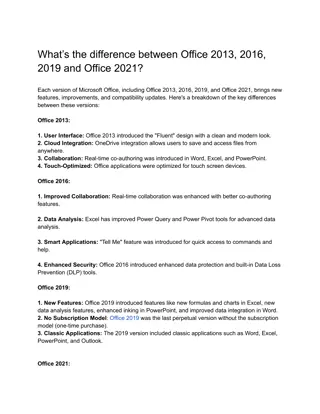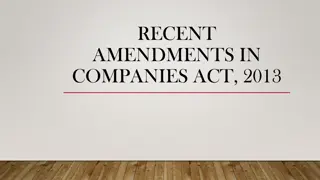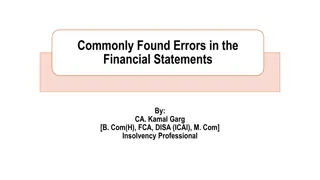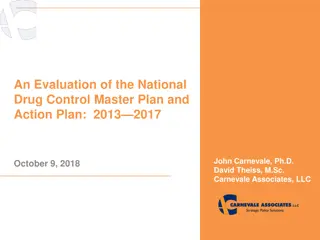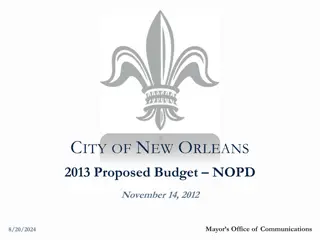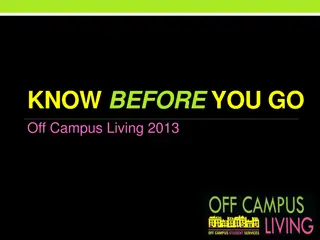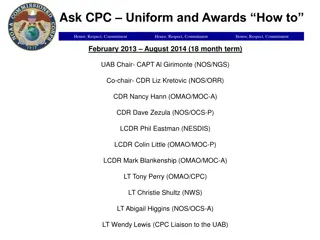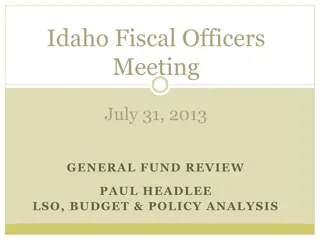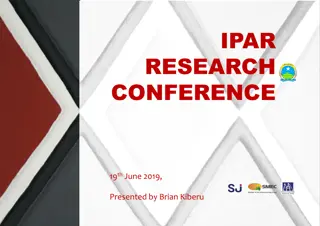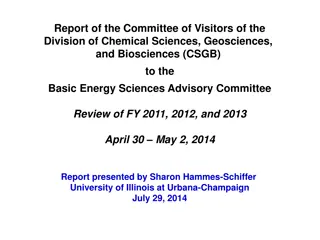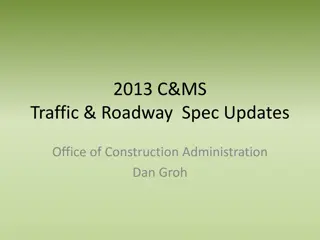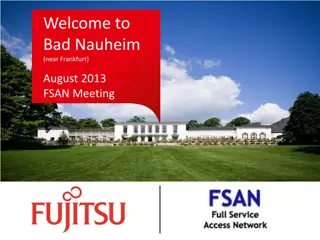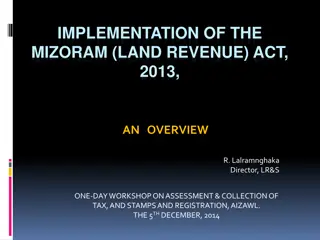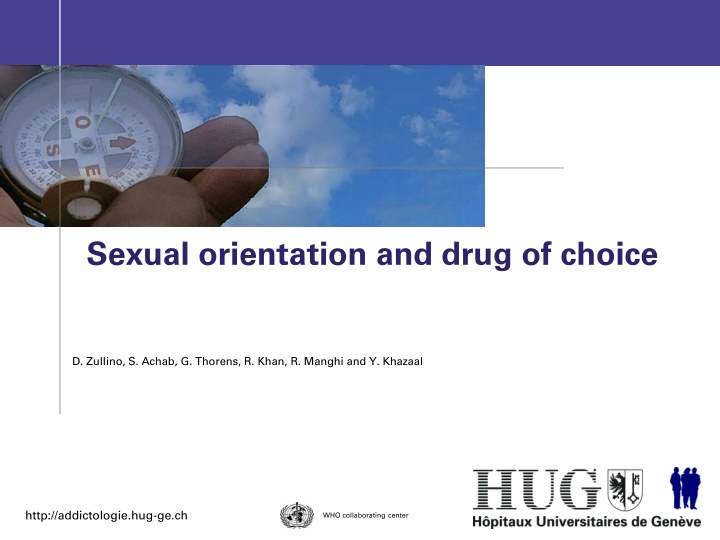
Relationship Between Sexual Orientation and Substance Use
Explore how substance use issues are more prevalent in lesbian, gay, and bisexual populations, with hypotheses, methodological flaws, and the multidimensional construct of sexual orientation discussed. The rationale for the rarity of longitudinal studies on substance consumption in Europe, particularly in Switzerland, is also highlighted.
Download Presentation

Please find below an Image/Link to download the presentation.
The content on the website is provided AS IS for your information and personal use only. It may not be sold, licensed, or shared on other websites without obtaining consent from the author. If you encounter any issues during the download, it is possible that the publisher has removed the file from their server.
You are allowed to download the files provided on this website for personal or commercial use, subject to the condition that they are used lawfully. All files are the property of their respective owners.
The content on the website is provided AS IS for your information and personal use only. It may not be sold, licensed, or shared on other websites without obtaining consent from the author.
E N D
Presentation Transcript
Sexual orientation and drug of choice D. Zullino, S. Achab, G. Thorens, R. Khan, R. Manghi and Y. Khazaal http://addictologie.hug-ge.ch WHO collaborating center
Introduction Substance use problems usually found to be more prevalent in lesbian, gay, and bisexual (LGB) populations http://addictologie.hug-ge.ch
Hypotheses Green & Feinstein, 2012; Meyer, 1995, 2003 Affiliation with gay culture LGB communities centered on activities involving consumption (e.g. bars, circuit parties). Can lead to social networks of LGB individuals with heavier consumption Can make it more difficult to avoid triggers for substance use (e.g. bars, peers who drink) Demographic factors (female, older age) less robust protective factors Stress related to being a sexual minority (Minority stress model) Bisexual identity : particularly related to increased risk for substance abuse http://addictologie.hug-ge.ch
Methodological flaws in the existing research Bux, 1996 Recruitment of participants from bars Lack of appropriate comparison groups Poor assessment of multiple dimensions of sexual orientation http://addictologie.hug-ge.ch
Sexual orientation: multidimensional construct Green & Feinstein, 2012; McCabe et al., 2009 at least 3 components sexual attraction refers to the desire to have sexual relations with one or both sexes sexual behavior refers to any mutually voluntary activity with another person that involves genital contact and sexual arousal, even if intercourse or orgasm did not occur sexual identity refers to personally selected labels attached to the perceptions and meanings individuals have about their sexuality The 3 components are not perfectly correlated with one another May be differentially associated with psychological outcomes http://addictologie.hug-ge.ch
Rationale Longitudinal studies on substance consumption rare and costly Mostly realized in North America, where youth culture is multiple Studies are rare in Europe Switzerland stands in the head of European countries with regard to substance consumption rates by teenagers http://addictologie.hug-ge.ch
C-SURF Cohort study Coordinated by Centre hospitalier universitaire vaudois (CHUV), Lausanne Social and Preventive Medicine Institute at Z rich University Financial support of the Swiss National Research Foundation Seeks to follow substance consumption by 19-year-old-young adults during at least 10 years concerns young Swiss adults who have to go through the mandatory recruitment process at the Swiss army covers 98% of the Swiss male 18-year-old http://addictologie.hug-ge.ch
Collaborating centers Division of Addictology, Department of mental health and psychiatry, Geneva CHUV, University Hospital Center of the Canton of Vaud, Lausanne IUMSP Institute of Social and Preventive Medicine, Lausanne DUMSC, Department of Medicine and Community Health, Lausanne AS Addiction Switzerland, Lausanne ISPM, Institute for Social and Preventive Medicine, Z rich Institute for Social and Preventive Medicine, Geneva ISGF, Institute for Research in Addiction and Health, Z rich University Hospital of Erlangen, Germany Center for Alcohol and Addiction Studies, USA http://addictologie.hug-ge.ch
Subjects All young men at the army recruitment centers in Lausanne, Windisch and Mels invited to participate n = 5,387 Data collected between August 2010 and November 2011 http://addictologie.hug-ge.ch
Questionnaire Online questionnaire (a hard copy sent by post if wished) 45 - 60 minutes socioprofessional and family background lifestyle and personality consumption of tobacco, alcohol, cannabis and other drugs gambling and gaming activities and use of internet sexuality physical and mental health knowledge about other health-related aspects http://addictologie.hug-ge.ch
Analyses Proportions, mean values and standard deviations to describe general characteristics Between-group differences by one-way ANOVAs and chi- square Significance set at p<0.05 Multinomial logistic regression for association between sexual preference and a set of independent variables http://addictologie.hug-ge.ch
Sexual preferences 89.7% considered themselves exclusively heterosexuals and 1% exclusively homosexuals Bisexual attraction reported by 7.4% 1.9% avoided the question regarding their sexual preference http://addictologie.hug-ge.ch
Lifetime consumption Exclusively heterosexual (n=5 371) 86.7 Exclusively homosexual (n=62) 77.4 Bisexually attracted (n=442) 88.7 Ever drunk > 12 alcoholic beverages? Ever smoke > 50 cigarettes Ever smoked cannabis Magic mushrooms Other hallucinogens (LSD, PCP/Angeldust, etc.) Salvia divinarum Speed Amphetamines Chrystal Meth (Ice) Poppers Glue sniffing Ecstasy, MDMA Cocaine, crack, freebase Heroin Ketamines GHB/GBL/1-4 butandiol (BDB) ns <0.001 <0.001 <0.001 38.6 46.5 5.4 4 41.9 45.4 11.3 11.3 49.2 58.5 9.4 7 <0.001 ns <0.05 <0.001 <0.001 <0.001 <0.001 <0.001 <0.001 <0.001 <0.001 <0.001 5.1 4.5 3.1 1.1 4.7 4.4 5.3 3 0.4 0.5 0.4 6.5 11.3 14.5 1.6 25.8 11.3 14.5 9.7 1.6 4.8 3.2 5.9 6.3 5.2 1.6 7.7 7.7 9.9 5.4 0.7 0.9 1.1 http://addictologie.hug-ge.ch
Last year consumption Exclusively heterosexual (n=5 371) 92 46.4 29.7 2.6 2.1 Exclusively homosexual (n=62) 90.3 51.6 30.6 6.5 9.7 Bisexually attracted (n=442) 91.6 56.9 40.8 3.8 3.9 The? last? 12? months > 12 alcoholic beverages? > 50 cigarettes Cannabis Magic mushrooms - Other hallucinogens (LSD, PCP/Angeldust, etc.) - Salvia divinarum - Speed - Amphetamines - Chrystal Meth (Ice) - Poppers - Glue sniffing - Ecstasy, MDMA - Cocaine, crack, freebase - Heroin - Ketamines - GHB/GBL/1-4 butandiol (BDB) ns ns ns ns ns 2.1 2.5 1.7 0.4 2 2 3.4 3 0.4 0.5 0.4 3.2 3.1 9.7 1.6 19.4 6.5 11.3 9.7 1.6 4.8 3.2 2.5 4.1 4.7 0.5 4.5 3.9 6.6 5.4 0.7 0.9 1.1 ns ns <0.05 ns <0.01 ns ns ns ns ns ns http://addictologie.hug-ge.ch
Multinomial logistic regression: Independent variables Number of alcoholic beverages consumed during a typical day Frequency of alcohol consumption during a typical week Number of cigarettes smoked during a typical day Smoking frequency in the past year Number of illicit substances used in the past year (composite variable) http://addictologie.hug-ge.ch
Multinomial logistic regression Sexual preferencea Variable Sig. Exp (B) 95% C.I. for exp (B) Lower - Upper - Intercept 0.00005 - exclusively homosexual Number of alcoholic beverages Number of cigarettes smoked Number of illicit substances used Frequency of alcohol consumption - 4-7 days a week - 3 days a week or less Smoking frequency - 5-7 days a week - 4 days a week or less Intercept 0.06 0.08 0.002 0.88 1.05 1.23 0.78 0.99 1.08 1 1.11 1.41 0.3 0 0.58 - 0.19 - 1.75 - 0.6 0 0.00005 0.78 - - 0.29 - - 2.08 - - Number of alcoholic beverages Number of cigarettes smoked Number of illicit substances used Frequency of alcohol consumption - 4-7 days a week - 3 days a week or less Smoking frequency - 5-7 days a week - 4 days a week or less 0.009 0.2 0.003 0.95 0.98 1.12 0.91 0.96 1.04 0.99 1.01 1.2 bisexually attracted 0.4 0 1.15 - 0.8 - 1.66 - 0.8 0 1.04 - 0.73 - 1.48 - http://addictologie.hug-ge.ch
College studies Jasinski & Ford, 2008; McCabe et al, 2005 Gay men significantly less likely to binge drink than heterosexual men Gay men significantly less likely to endorse norms that are permissive of binge drinking Elevated rates of binge drinking in college samples canceling out the typical LGB/heterosexual differences during this period ? http://addictologie.hug-ge.ch
Conclusions Homosexual men Higher proportion of lifetime drug use (excepted alcohol and cannabis) Maintain popper and amphetamine consumption until age 20 Hypothesis: gay culture effect? Bisexual men Higher proportion of lifetime cigarette and cannabis use Higher tendency to maintain cigarette and cannabis use until age 20 Less drinks/day Maintain popper and amphetamine use, but at lesser proportion than homosexual men Hypothesis: less affiliated to gay culture, more tendency to consume for (minority)stress-reduction? http://addictologie.hug-ge.ch
Service daddictologie Centre collaborateur OMS pour l enseignement et la recherche sur les addictions http://addictologie.hug-ge.ch

